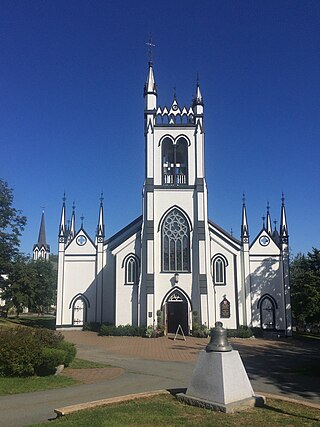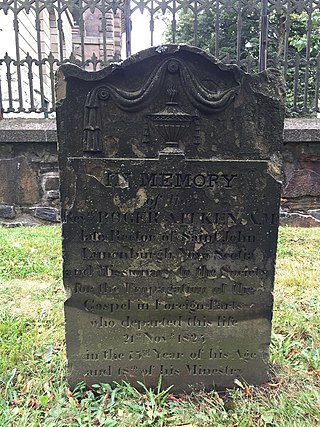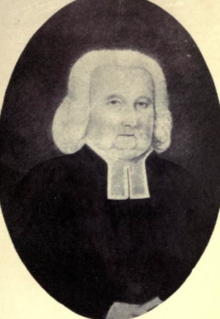
The Presbyterian Church in Canada is a Presbyterian denomination, serving in Canada under this name since 1875. The United Church of Canada claimed the right to the name from 1925 to 1939. According to the Canada 2001 Census 409,830 Canadians identify themselves as Presbyterian, that is, 1.4 percent of the population.

St. Matthew's United Church is a United Church of Canada church in downtown Halifax, Nova Scotia. The church was founded at the same time as the original colony in 1749 as a home for the various groups of dissenting Protestants who were from New England and who did not follow the Church of England. It originally met Sunday afternoons in St. Paul's Church, the Church of England building completed in 1750. The church got its own home in 1754 when a church was constructed at Hollis and Prince streets. This building was destroyed by fire in 1857, and a new church was built at the current location at 1479 Barrington Street, land parcelled off of the Black-Binney House estate by Bishop Hibbert Binney. The church used the Old Burying Ground.

St. Paul's Church is an evangelical Anglican church in downtown Halifax, Nova Scotia, within the Diocese of Nova Scotia and Prince Edward Island of the Anglican Church of Canada. It is located at the south end of the Grand Parade, an open square in downtown Halifax with Halifax City Hall at the northern end.

The Old Burying Ground is a historic cemetery in Halifax, Nova Scotia, Canada. It is located at the intersection of Barrington Street and Spring Garden Road in Downtown Halifax.

Jonathan Leavitt (1764–1830) was a prominent Greenfield, Massachusetts attorney, judge, state senator and businessman for whom the architect Asher Benjamin designed the Leavitt House, now the Leavitt-Hovey House on Main Street, in 1797.

Beamish Murdoch was a lawyer, historian, and political figure in Nova Scotia. He represented Halifax township in the Nova Scotia House of Assembly from 1826 to 1830. He was born in Halifax, Nova Scotia, the son of Andrew Murdoch and Elizabeth Beamish. His family had come to Nova Scotia from the North of Ireland. His grandfather, a Presbyterian minister, Rev. James Murdoch served several parishes in the Province for 23 years. Murdoch was admitted to the Nova Scotia bar in 1822. In 1824 he was elected Vice - President of the Charitable Irish Society in Halifax. He also contributed articles to the Acadian Recorder and the Acadian Magazine or Literary Mirror. Murdoch was defeated by Stephen Wastie Deblois when he ran for reelection in 1830; he was an unsuccessful candidate again in 1836 and 1840. He served as president of the Halifax Temperance Society. In 1841, Murdoch became clerk for the Central Board of Education and, in 1852, was named record for the city of Halifax. Between 1865 and 1867, he published A History of Nova-Scotia, Or Acadie. He died in Lunenburg at the age of 75. He is buried with a gravestone at the Hillcrest Cemetery.

The Raid on Lunenburg occurred during the American Revolution when the US privateer, Captain Noah Stoddard of Fairhaven, Massachusetts, and four other privateer vessels attacked the British settlement at Lunenburg, Nova Scotia on July 1, 1782. The raid was the last major privateer attack on a Nova Scotia community during the war.

The Foreign Protestants were a group of French Lutheran and German Protestant immigrants to Nova Scotia. They largely settled in Halifax at Gottingen Street and Dutch Village Road as well as Lunenburg.
George Washington Sprott was Scottish minister and liturgical scholar, known as an advocate of reform of the services of the Church of Scotland, and of its reunion with the Free Church of Scotland.
Donald Allan Fraser was a Scottish-born Presbyterian minister in Nova Scotia and Newfoundland.

St. John's Anglican Church was the first church established in Lunenburg, Nova Scotia, Canada (1753). It is the second Church of England built in Nova Scotia, and is the second oldest continuous Protestant church in present-day Canada. Early on 1 November 2001, St. John's church suffered significant damage by fire. It was restored and re-dedicated June 12, 2005.
James Cuppaidge Cochran (1798–1880) was an Anglican priest and editor in Lunenburg and Halifax, Nova Scotia. He was a minister at St. John's Anglican Church (Lunenburg) (1825-1852). He also published both the Colonial Churchman (1835-1840) in Lunenburg and later the Church Times in Halifax. While in Halifax, he supported the establishment of the Halifax School for the Deaf. He is the son of Rev. William Cochran (clergyman), the founder of King's College, Nova Scotia.

Jean-Baptiste Moreau was first minister at St. John's Anglican Church (Lunenburg) (1753-1770) and one of the founding fathers of the community. He was one of two missionaries who first arrived in Halifax with Edward Cornwallis (1749) and served at St. Paul's Church (Halifax). His wife had the first child born in Halifax and was named Cornwallis after the Governor. Then in 1753 he was sent to help establish Lunenburg, Nova Scotia. Rev Moreau served the community throughout the French and Indian War. He reported to Society for Propagation of the Gospel (SPG) in London, "…the number massacred by Indians in Lunenburg District during the War was 32." He learned the Mi'kmaw language and is reported to have baptised a number of Mi'kmaq children. He is buried in the crypt of St. John's Anglican Church

St. Andrew's Presbyterian Church is a church in Lunenburg, Nova Scotia. The congregation is the longest history of any Presbyterian congregation in Canada. After meeting at a private house, the congregation worshipped in St. John's Anglican Church (Lunenburg) (1759-1770). The first church was built in 1770 and the first minister was Reverend Bruin Romkes Comingo, who served the community for 50 years until he died at age 95 (1820). The current church was built in the neo-gothic style and dates from 1828.
The Hillcrest Cemetery is the oldest protestant cemetery in Lunenburg, Nova Scotia and one of the oldest in Canada. The cemetery is adjacent to the Lunenburg Academy. The oldest marker is dated 1761, eight years after Lunenburg was established. Hillcrest Cemetery contains 5 Commonwealth war graves from World War I and one from World War II.
The Old Parish Burying Ground is the oldest protestant cemetery in Windsor, Nova Scotia and one of the oldest in Canada. The graveyard was located adjacent to the first protestant church in Windsor (1788). The oldest marker is dated 1771, twelve years after the New England Planters began to settle the area.

Roger Aitken was a Scottish Anglican priest known for his service as a missionary at Lunenburg, Nova Scotia (1817-1825) for the Society for the Propagation of the Gospel in Foreign Parts. He was the rector at St. John's Anglican Church and was instrumental in gaining construction of the Rectory and in founding St. Peter's Anglican Church, New Dublin.

Rev. John Seccombe was an author, a founder of Chester, Nova Scotia and was “the best-known and most highly respected clergyman in Nova Scotia.” He was also the author of Father Abbey's Will, which was printed as a poem and a broadsheet over 30 times throughout the 18th century in England and America. According to the Manual of American Literature, the poem "was one of the best comic poems of that day." As a result of the poem, the History of American Literature indicated that Seccombe "had an extraordinary notoriety" in America's early literary history.
Rev. John Frost was the first ordained Protestant minister in present-day Canada.. The "irregular ordination" happened on 21 September 1769. Contrary to accepted practice, the ordination took place without the assistance or representation of any other church body or association. Two years earlier, on 18 December 1767, the Chebogue church chose Frost to be its minister.

Perry Francis Rockwood was a Canadian fundamentalist Christian minister and radio broadcaster, who founded the weekly People's Gospel Hour program in 1947 on a station in Truro, Nova Scotia. His broadcast eventually reached a worldwide audience. Rockwood also started publication of a monthly magazine, The Gospel Standard, and wrote numerous books, distributed from his organization's headquarters in Halifax, Nova Scotia.














